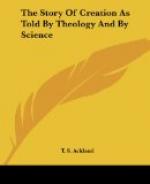Then there are a vast number of peculiarities which are certainly not ornamental in our eyes, but which are confined to the male sex. They are, so far as we can tell, of no service whatever in the struggle of life. With reference to these Mr. Darwin’s argument seems to be this,—“They can serve no other purpose with which we are acquainted, therefore they must be attractive to the female—therefore they must be acquired by sexual selection.” Such arguments as these cannot carry much weight. [Footnote: Descent of Man, vol ii p 284.]
On the whole, we can hardly come to any other conclusion than that the theory of sexual selection is not proved. In many cases it is known that such selection is not the result of choice; in other cases, where choice seems probable, we have no ground for believing that external appearance is the sole ground of that choice. It may exercise some influence, but that is all. Even if admitted, there are many things which cannot be accounted for by it without very extravagant assumptions. It cannot then be admitted as covering the large classes of phenomena left unaccounted for by the theory of natural selection.
So far as the lower animals are concerned, the results to which an examination of Mr. Darwin’s views has led us may be summed up in the following propositions:—
1. That the two causes, natural and sexual selection, have probably exercised some influence in the modification of animal forms; but that the laws of probability preclude our entertaining the belief that these causes can have had, by themselves, and apart from a superintending power, anything beyond a very limited operation.
2. That in cases where there have been related changes in different parts of the same organism, or in different organisms, the inadequacy of these two causes is virtually admitted by the introduction of certain supposed laws; and that these laws, being defined by Mr. Darwin to be no more than “the ascertained sequence of events,” cannot be regarded as efficient causes, and so cannot supply the defect.
3. That there are particular points in the chain of life, in which the transition from one form to another is so great, and so incapable of graduation, that it is impossible to suppose that these two causes can have been adequate to produce it. Of this a notable instance is to be found in the transition from oviparous animals to the mammalia.




